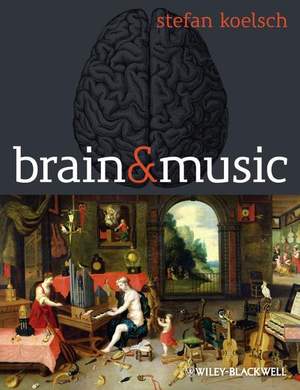
Brain and Music
- Author: Koelsch, Stefan
Book
$114.25Contents
- Preface ix
- Part I Introductory Chapters 1 1 Ear and Hearing 3
- 1. 1 The ear 3
- 1. 2 Auditory brainstem and thalamus 6
- 1. 3 Place and time information 8
- 1. 4 Beats, roughness, consonance and dissonance 9
- 1. 5 Acoustical equivalency of timbre and phoneme 11
- 1. 6 Auditory cortex 12 2 Music-theoretical Background 17
- 2. 1 How major keys are related 17
- 2. 2 The basic in-key functions in major 20
- 2. 3 Chord inversions and Neapolitan sixth chords 21
- 2. 4 Secondary dominants and double dominants 21 3 Perception of Pitch and Harmony 23
- 3. 1 Context-dependent representation of pitch 23
- 3. 2 The representation of key-relatedness 26
- 3. 3 The developing and changing sense of key 29
- 3. 4 The representation of chord-functions 30
- 3. 5 Hierarchy of harmonic stability 31
- 3. 6 Musical expectancies 35
- 3. 7 Chord sequence paradigms 36 4 From Electric Brain Activity to ERPs and ERFs 40
- 4. 1 Electro-encephalography (EEG) 43
- 4.1. 1 The 10 20 system 43
- 4.1. 2 Referencing 45
- 4. 2 Obtaining event-related brain potentials (ERPs) 45
- 4. 3 Magnetoencephalography (MEG) 48
- 4.3. 1 Forward solution and inverse problem 49
- 4.3. 2 Comparison between MEG and EEG 49 5 ERP Components 51
- 5. 1 Auditory P1, N1, P2 51
- 5. 2 Frequency-following response (FFR) 53
- 5. 3 Mismatch negativity 54
- 5.3. 1 MMN in neonates 57
- 5.3. 2 MMN and music 57
- 5. 4 N2b and P300 59
- 5. 5 ERP-correlates of language processing 59
- 5.5. 1 Semantic processes: N400 60
- 5.5. 2 Syntactic processes: (E)LAN and P600 63
- 5.5. 3 Prosodic processes: Closure Positive Shift 67 6 A Brief Historical Account of ERP Studies of Music Processing 70
- 6. 1 The beginnings: Studies with melodic stimuli 70
- 6. 2 Studies with chords 74
- 6. 3 MMN studies 75
- 6. 4 Processing of musical meaning 76
- 6. 5 Processing of musical phrase boundaries 77
- 6. 6 Music and action 77 7 Functional Neuroimaging Methods: fMRI and PET 79
- 7. 1 Analysis of fMRI data 81
- 7. 2 Sparse temporal sampling in fMRI 84
- 7. 3 Interleaved silent steady state fMRI 85
- 7. 4 Activation vs. activity change 85
- Part II Towards a New Theory of Music Psychology 87 8 Music Perception: A Generative Framework 89 9 Musical Syntax 98
- 9. 1 What is musical syntax? 98
- 9. 2 Cognitive processes 102
- 9. 3 The early right anterior negativity (ERAN) 109
- 9.3. 1 The problem of confounding acoustics and possible solutions 113
- 9.3. 2 Effects of task-relevance 120
- 9.3. 3 Polyphonic stimuli 121
- 9.3. 4 Latency of the ERAN 127
- 9.3. 5 Melodies 127
- 9.3. 6 Lateralization of the ERAN 129
- 9. 4 Neuroanatomical correlates 131
- 9. 5 Processing of acoustic vs. music-syntactic irregularities 133
- 9. 6 Interactions between music- and language-syntactic processing 138
- 9.6. 1 The Syntactic Equivalence Hypothesis 145
- 9. 7 Attention and automaticity 147
- 9. 8 Effects of musical training 149
- 9. 9 Development 151 10 Musical Semantics 156
- 10. 1 What is musical semantics? 156
- 10. 2 Extra-musical meaning 158
- 10.2. 1 Iconic musical meaning 158
- 10.2. 2 Indexical musical meaning 159 Excursion: Decoding of intentions during musinc listening 161
- 10.2. 3 Symbolic musical meaning 162
- 10. 3 Extra-musical meaning and the N400 163
- 10. 4 Intra-musical meaning 170 Excursion: Posterior temporal cortex and processing of meaning 166
- 10.4. 1 Intra-musical meaning and the N5 171
- 10. 5 Musicogenic meaning 177
- 10.5. 1 Physical 177
- 10.5. 2 Emotional 179
- 10.5. 3 Personal 180
- 10. 6 Musical semantics 181
- 10.6. 1 Neural correlates 181
- 10.6. 2 Propositional semantics 182
- 10.6. 3 Communication vs. expression 182
- 10.6. 4 Meaning emerging from large-scale relations 183
- 10.6. 5 Further theoretical accounts 184 11 Music and Action 186
- 11. 1 Perception action mediation 186
- 11. 2 ERP correlates of music production 189 12 Emotion 203
- 12. 1 What are musical emotions ? 204
- 12. 2 Emotional responses to music underlying mechanisms 207
- 12. 3 From social contact to spirituality The Seven Cs 208
- 12. 4 Emotional responses to music underlying principles 212
- 12. 5 Musical expectancies and emotional responses 216
- 12.5. 1 The tension-arch 218
- 12. 6 Limbic and paralimbic correlates of music-evoked emotions 219
- 12.6. 1 Major minor and happy sad music 225
- 12.6. 2 Music-evoked dopaminergic neural activity 226
- 12.6. 3 Music and the hippocampus 227
- 12.6. 4 Parahippocampal gyrus 231
- 12.6. 5 A network comprising hippocampus, parahippocampal gyrus, and temporal poles 232
- 12.6. 6 Effects of music on insular and anterior cingulate cortex activity 232
- 12. 7 Electrophysiological effects of music-evoked emotions 233
- 12. 8 Time course of emotion 234
- 12. 9 Salutary effects of music making 235 13 Concluding Remarks and Summary 241
- 13. 1 Music and language 241
- 13. 2 The music-language continuum 244
- 13. 3 Summary of the theory 249
- 13. 4 Summary of open questions 258
- References 267
- Index 303



